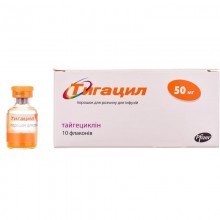



 Secure and encrypted payment processing
Secure and encrypted payment processing We ship to over 40 countries including the USA, UK, Europe, Australia and Japan
We ship to over 40 countries including the USA, UK, Europe, Australia and Japan Guaranteed refund or reship if you haven't received your order
Guaranteed refund or reship if you haven't received your orderTygacil is prescribed for adults and children over the age of 8 for the treatment of:
Tygacil should only be used in cases where other antibiotics are not acceptable.
You should pay attention to official recommendations regarding the appropriate use of antibacterial agents.
active substance: tigecycline;
1 vial contains 50 mg of tigecycline;
excipients: lactose monohydrate, dilute hydrochloric acid; sodium hydroxide.
Tigecycline, an antibiotic of the glycylcycline series, inhibits protein translation in bacteria by attaching to the 30S ribosomal subunit and blocking the entry of amino-acyl-tRNA molecules into the ribosome A site. This prevents the inclusion of amino acid residues in building peptide chains.
Hypersensitivity to the active substance or to any of the excipients indicated in the "Composition" section.
Patients with hypersensitivity to tetracycline antibiotics may have hypersensitivity to tigecycline.
Dosage
Adults
The initial recommended dose is 100 mg; in the future, 50 mg every 12:00 should be used for 5-14 days.
The duration of treatment should be chosen depending on the severity of the disease, the location of the infection and the clinical response of the patient.
Children and adolescents (ages 8 to 17).
Taigecycline should be used to treat children from 8 years old only after consulting a doctor who has sufficient experience in treating infections.
Pregnancy. There is no information on the use of tigecycline for pregnant women or its quantity is limited. Animal studies have shown reproductive toxicity. The potential risk to humans is unknown. Like tetracycline antibiotics, tigecycline can cause persistent tooth damage (discoloration and enamel defects) and delay fetal ossification during exposure in utero in the second half of pregnancy, as well as in children under 8 years of age as a result of accumulation in tissues with high the level of calcium metabolism and the formation of chelate complexes containing calcium. Tigecycline should not be used by pregnant women, except in clinical cases when a woman requires the use of tigecycline.
The period of breastfeeding. Unknown, tigecycline / metabolites penetrate into breast milk. Available pharmacodynamic / toxicological data from animal studies show that tigecycline / metabolites penetrate into milk. The risk to newborns / infants in humans cannot be excluded. A decision must be made whether to discontinue breastfeeding or to discontinue / discontinue tigecycline therapy, taking into account the benefits of breastfeeding for the baby and the benefits of therapy for the woman.
Fertility. Tigecycline did not affect mating or fertility in rats when used in doses 4.7 times the human dose based on AUC values. In female rats, drug-related effects on the ovaries or ovarian cycles were not observed when used in doses 4.7 times higher than the human dose based on the AUC value.
The safety and effectiveness of Tygacil for children under 8 years of age have not been established. No data on this.
Tygacil should not be used in children under 8 years of age due to discoloration of the teeth.
When applying tigecycline, dizziness may occur, which may affect the ability to drive vehicles and other mechanisms.
There is no specific information on the treatment of overdose. With a single administration of 300 mg of tigecycline for 60 minutes, intravenously healthy volunteers observed an increase in the incidence of nausea and vomiting.
Tigecycline is not removed by hemodialysis in a significant amount.
A total of 2,393 patients with complicated skin and soft tissue infections and complicated intra-abdominal infections were treated with tigecycline during phases 3 and 4 of clinical trials.
During clinical trials, the most frequent adverse reactions associated with the use of the drug were nausea (21%) and vomiting (13%). These reactions were in most cases mild or moderate, usually developed at the beginning of treatment (after 1-2 days) and were reversible.
The interaction study was conducted only with adults.
The simultaneous use of tigecycline and warfarin (25 mg once) for healthy volunteers led to a decrease in the clearance of R-warfarin and S-warfarin by 40% and 23% and to an increase in AUC by 68% and 29%, respectively. The mechanism of this interaction is still not known. According to the available data, it cannot be assumed that this interaction can lead to significant changes in the international normalized ratio. However, since tigecycline can prolong both prothrombin time and activated partial thromboplastin time, the results of coagulation studies should be carefully monitored while using tigecycline with anticoagulants. Warfarin did not affect the pharmacokinetic profile of tigecycline.
Taigecycline is not characterized by extensive metabolism. So, it is expected that active substances that are inhibitors or inducers of CYP450 isoforms did not affect its clearance. Tigecycline in vitro does not exhibit the properties of a competitive inhibitor or inhibitor of the irreversible action of CYP450 enzymes.
Tigecycline at recommended doses does not affect the rate or extent of absorption or digoxin clearance (0.5 mg, and then 0.25 mg daily) when used by healthy adult volunteers. Digoxin does not affect the pharmacokinetic profile of tigecycline. Therefore, with the simultaneous use of tigecycline with digoxin, there is no need for dose adjustment.
In in vitro studies, no antagonism was found between tigecycline and antibiotics of other classes, which are often used in therapy.
The simultaneous use of antibiotics with oral contraceptives can reduce the effectiveness of contraceptives.
According to an in vitro study, tigecycline is a substrate of P-glycoprotein. Combined use with P-glycoprotein inhibitors (e.g. ketoconazole or cyclosporine) or P-glycoprotein inducers (e.g. rifampicin) may affect the pharmacokinetics of tigecycline.
Keep out of reach of children at a temperature not exceeding 25 ° C.
The prepared solution should be used immediately.
Shelf life is 2 years.